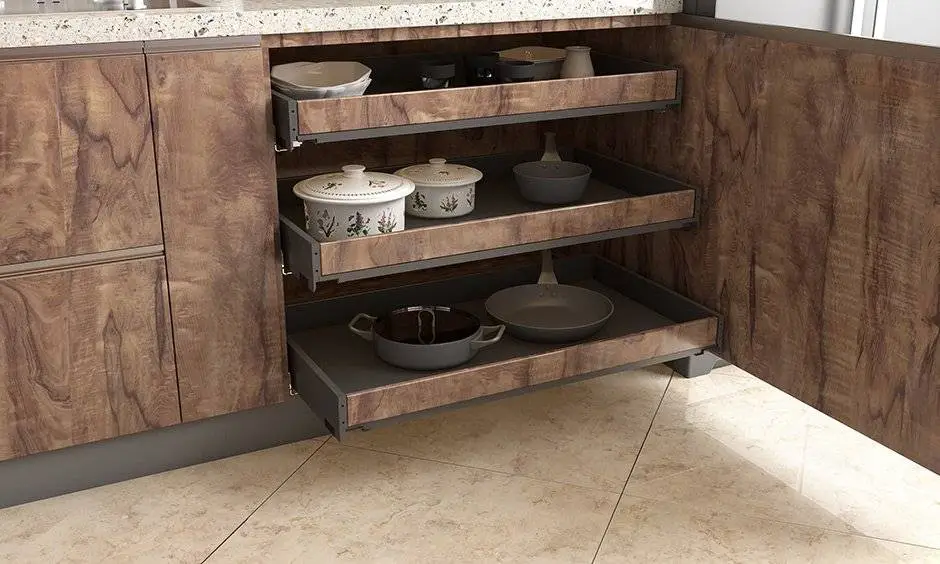When designing a kitchen, it’s important to understand the different modular kitchen units or cabinets that help organize storage, make cooking efficient, and enhance the kitchen's look. These units are built to fit your kitchen layout and needs.
1. Base Units (Lower Cabinets)
These are the main storage cabinets fixed to the floor, and they support the kitchen countertop.
What they do:
-
Store pots, pans, plates, cutlery
-
Hold the gas cylinder or hob
-
Provide working space on top
Types:
-
Sink Base Unit – below the sink for plumbing
-
Drawer Units – sliding drawers for easy access
-
Open Shelf Units – for heavy items like pressure cookers
Pro Tip: Use soft-close drawers to avoid noise and wear-and-tear.
2. Wall Units (Upper Cabinets)
These are cabinets mounted on the wall above the countertop.
Use:
-
To store light items like spices, glasses, or dry groceries
-
Keeps frequently used things within reach
Options:
-
Swing Door Units – traditional shutter cabinets
-
Lift-Up Units – opens upward, modern style
-
Open Shelves – for display or daily essentials
Pro Tip: Keep these at a reachable height and avoid overloading.
Also Read: Top kitchen cabinet color idea for 2025
3. Tall Units (Pantry Units)
These are floor-to-ceiling cabinets used for extra storage.
Why use them?
-
Perfect for storing groceries in bulk
-
Can include a built-in microwave or oven
-
Stores cleaning supplies or appliances
Best for: Big kitchens and families who need more space.
4. Loft Units
These are the topmost cabinets, installed above wall units close to the ceiling.
Purpose:
-
Store rarely used items like extra vessels, pickle jars, or festive utensils
Pro Tip: Use waterproof plywood or marine plywood to avoid damage from heat and moisture.
5. Corner Units
Corners often go unused. These special units help you maximize corner spaces.
Types:
-
L-shaped storage
-
Magic Corner Units – pull-out system for hidden corners
-
Carousel Racks (Lazy Susan) – rotating trays
Pro Tip: Invest in corner systems to avoid bending and reaching deep spaces.
6. Under-Sink Units
This unit goes below the kitchen sink and includes space for plumbing.
Use:
-
Storing cleaning items (dishwash liquid, gloves, brushes)
-
Pull-out dustbins
Pro Tip: Use water-resistant material and ensure ventilation.
7. Appliance Garage / Small Appliance Unit
A neat way to hide small kitchen appliances like mixers, toasters, and coffee makers.
Use:
-
Keeps counter clutter-free
-
Safe place for daily-use appliances
Pro Tip: Install roller shutters or sliding doors for easy access.
Kitchen Layouts that Work with These Units
Depending on your kitchen size and shape, the units are arranged in different layouts:
| Layout Type | Description | Best For |
|---|---|---|
| L-Shaped | Counter runs along 2 walls | Small to medium kitchens |
| U-Shaped | 3 walls with base + wall units | Large families, maximum storage |
| Parallel (Galley) | 2 counters opposite each other | Narrow kitchens |
| Island Kitchen | Free-standing island in the center | Spacious, modern kitchens |
Final Tips for Designing Kitchen Units
-
Always plan based on how you cook – daily use, family size, etc.
-
Use a mix of drawers, cabinets, and pull-outs
-
Prioritize easy-to-clean materials (like acrylic or laminate)
-
Add under-cabinet lighting for a bright workspace
-
Invest in good chimney and ventilation
https://www.livehomes.in/blogs













